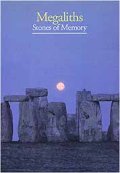<< News >> A 20ft-high palisade hid Stonehenge 5,000 years ago
Submitted by coldrum on Thursday, 11 September 2008 Page Views: 8354
StonehengeTourists who complain about the fence put up around Stonehenge in the Seventies should spare a thought for their Neolithic ancestors... they couldn't even see the site because of a huge wooden barrier.Archaeologists have found traces of the 20ft-high timber fence that snaked almost two miles across Salisbury Plain and hid sacred ceremonies from unworthy locals more than 5,000 years ago. Now trenches have been dug along the line researchers believe the palisade took as it stretched from the east of the ancient stone circle, past the Heel Stone, to the west before heading south.
Experts believe that the time and energy taken to construct such a barrier, which has no other practical or defensive use, meant that it was designed to hide religious ceremonies from prying eyes. Dr Josh Pollard, of Bristol University, who is co-director of the dig, said: "The construction must have taken a lot of manpower. The palisade is an open structure which would not have been defensive and was too high to be practical for controlling livestock. It certainly wasn't for hunting herded animals and so, like everything else in this ceremonial landscape, we have to believe it must have had a religious significance. The most plausible explanation is that it was built at huge cost to the community to screen the environs of Stonehenge from view. Basically, we think it was to keep the lower classes from seeing what exactly their rulers and the priestly class were doing."
Mike Pitts, editor of British Archaeology Magazine and author of the book Hengeworld, said: "This huge wooden palisade would have snaked across the landscape, blotting out views to Stonehenge from one side. The other side was the ceremonial route to the Henge from the River Avon and would have been shielded by the contours. The palisade would have heightened the mystery of whatever ceremonies were performed and it would have endowed those who were privy to those secrets with more power and prestige. In modern terms, you had to be invited or have a ticket to get in. We hope to learn more about the structure, which we lose track of on the other side of the main A303 trunk road because any remains were obliterated by the construction of a wartime airfield."
Meanwhile, another team of scientists led by Professor Mike Parker Pearson of Sheffield University is working on a collection of partly cremated bones found at Stonehenge in the Thirties by amateur archaeologists. The task has been made very difficult because the remains have been put in two sacks and reburied in one spot. Mr Pitts said: "They were the remains of 50 burials at Stonehenge which were reburied in one hole in a complete mix-up. We think they were the bones of 50 kings and queens and may represent burials over a period of 1,000 years." Professor Parker Pearson has speculated that we may be looking at a dynasty at Stonehenge.
dailymail.






 We would like to know more about this location. Please feel free to add a brief description and any relevant information in your own language.
We would like to know more about this location. Please feel free to add a brief description and any relevant information in your own language. Wir möchten mehr über diese Stätte erfahren. Bitte zögern Sie nicht, eine kurze Beschreibung und relevante Informationen in Deutsch hinzuzufügen.
Wir möchten mehr über diese Stätte erfahren. Bitte zögern Sie nicht, eine kurze Beschreibung und relevante Informationen in Deutsch hinzuzufügen. Nous aimerions en savoir encore un peu sur les lieux. S'il vous plaît n'hesitez pas à ajouter une courte description et tous les renseignements pertinents dans votre propre langue.
Nous aimerions en savoir encore un peu sur les lieux. S'il vous plaît n'hesitez pas à ajouter une courte description et tous les renseignements pertinents dans votre propre langue. Quisieramos informarnos un poco más de las lugares. No dude en añadir una breve descripción y otros datos relevantes en su propio idioma.
Quisieramos informarnos un poco más de las lugares. No dude en añadir una breve descripción y otros datos relevantes en su propio idioma.